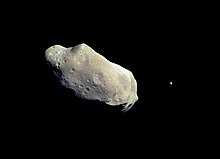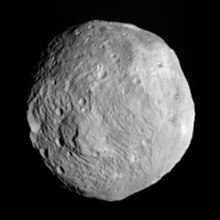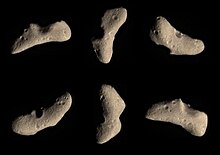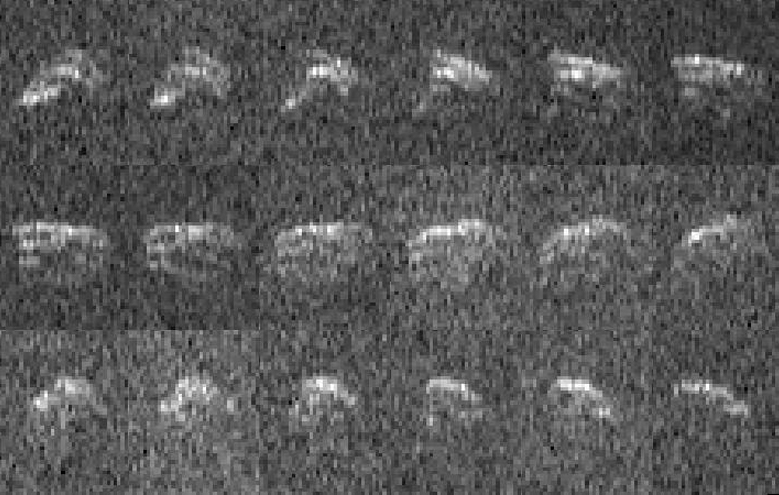Asteroids
(What is Asteroid?,Discovery,Asteroid belt,Trojans)
Asteroids are minor planets, especially those of the inner Solar System. The larger ones have
also been called planetoids. These terms have historically been applied
to any astronomical object orbiting the Sun that did not show the disc
of a planet and was not observed to have the characteristics of an
active comet. As minor planets in the outer Solar System were discovered
and found to have volatile-based surfaces that resemble those of
comets, they were often distinguished from asteroids of the asteroid
belt. In this article, the term "asteroid" refers to the minor planets
of the inner Solar System including those co-orbital with Jupiter.
There
are millions of asteroids, many thought to be the shattered remnants of
planetesimals, bodies within the young Sun's solar nebula that never
grew large enough to become planets. The large majority of known
asteroids orbit in the asteroid belt between the orbits of Mars and
Jupiter, or are co-orbital with Jupiter (the Jupiter trojans). However,
other orbital families exist with significant populations, including the
near-Earth objects. Individual asteroids are classified by their
characteristic spectra, with the majority falling into three main
groups: C-type, M-type, and S-type. These were named after and are
generally identified with carbon-rich, metallic, and silicate (stony)
compositions, respectively. The size of asteroids varies greatly, some
reaching as much as 1000 km across.
Asteroids
are differentiated from comets and meteoroids. In the case of comets,
the difference is one of composition: while asteroids are mainly
composed of mineral and rock, comets are composed of dust and ice. In
addition, asteroids formed closer to the sun, preventing the development
of the aforementioned cometary ice. The difference between asteroids
and meteoroids is mainly one of size: meteoroids have a diameter of less
than one meter, whereas asteroids have a diameter of greater than one
meter. Finally, meteoroids can be composed of either cometary or
asteroidal materials.
Only
one asteroid, 4 Vesta, which has a relatively reflective surface, is
normally visible to the naked eye, and this only in very dark skies when
it is favorably positioned. Rarely, small asteroids passing close to
Earth may be visible to the naked eye for a short time. As of March
2016, the Minor Planet Center had data on more than 1.3 million objects
in the inner and outer Solar System, of which 750,000 had enough
information to be given numbered designations.
The
United Nations declared June 30 as International Asteroid Day to
educate the public about asteroids. The date of International Asteroid
Day commemorates the anniversary of the Tunguska asteroid impact over
Siberia, Russian Federation, on 30 June 1908.
Discovery
 The
first asteroid to be discovered, Ceres, was found in 1801 by Giuseppe
Piazzi, and was originally considered to be a new planet.[note 1] This
was followed by the discovery of other similar bodies, which, with the
equipment of the time, appeared to be points of light, like stars,
showing little or no planetary disc, though readily distinguishable from
stars due to their apparent motions. This prompted the astronomer Sir
William Herschel to propose the term "asteroid",[10] coined in Greek as
ἀστεροειδής, or asteroeidēs, meaning 'star-like, star-shaped', and
derived from the Ancient Greek ἀστήρ astēr 'star, planet'. In the early
second half of the nineteenth century, the terms "asteroid" and "planet"
(not always qualified as "minor") were still used interchangeably.
The
first asteroid to be discovered, Ceres, was found in 1801 by Giuseppe
Piazzi, and was originally considered to be a new planet.[note 1] This
was followed by the discovery of other similar bodies, which, with the
equipment of the time, appeared to be points of light, like stars,
showing little or no planetary disc, though readily distinguishable from
stars due to their apparent motions. This prompted the astronomer Sir
William Herschel to propose the term "asteroid",[10] coined in Greek as
ἀστεροειδής, or asteroeidēs, meaning 'star-like, star-shaped', and
derived from the Ancient Greek ἀστήρ astēr 'star, planet'. In the early
second half of the nineteenth century, the terms "asteroid" and "planet"
(not always qualified as "minor") were still used interchangeably. Historical methods
Asteroid discovery methods have dramatically improved over the past two centuries.
In
the last years of the 18th century, Baron Franz Xaver von Zach
organized a group of 24 astronomers to search the sky for the missing
planet predicted at about 2.8 AU from the Sun by the Titius-Bode law,
partly because of the discovery, by Sir William Herschel in 1781, of the
planet Uranus at the distance predicted by the law. This task required
that hand-drawn sky charts be prepared for all stars in the zodiacal
band down to an agreed-upon limit of faintness. On subsequent nights,
the sky would be charted again and any moving object would, hopefully,
be spotted. The expected motion of the missing planet was about 30
seconds of arc per hour, readily discernible by observers.
The
first object, Ceres, was not discovered by a member of the group, but
rather by accident in 1801 by Giuseppe Piazzi, director of the
observatory of Palermo in Sicily. He discovered a new star-like object
in Taurus and followed the displacement of this object during several
nights. Later that year, Carl Friedrich Gauss used these observations to
calculate the orbit of this unknown object, which was found to be
between the planets Mars and Jupiter. Piazzi named it after Ceres, the
Roman goddess of agriculture.
Three
other asteroids (2 Pallas, 3 Juno, and 4 Vesta) were discovered over
the next few years, with Vesta found in 1807. After eight more years of
fruitless searches, most astronomers assumed that there were no more and
abandoned any further searches.
However,
Karl Ludwig Hencke persisted, and began searching for more asteroids in
1830. Fifteen years later, he found 5 Astraea, the first new asteroid
in 38 years. He also found 6 Hebe less than two years later. After this,
other astronomers joined in the search and at least one new asteroid
was discovered every year after that (except the wartime year 1945).
Notable asteroid hunters of this early era were J. R. Hind, Annibale de
Gasparis, Robert Luther, H. M. S. Goldschmidt, Jean Chacornac, James
Ferguson, Norman Robert Pogson, E. W. Tempel, J. C. Watson, C. H. F.
Peters, A. Borrelly, J. Palisa, the Henry brothers and Auguste Charlois.
In
1891, Max Wolf pioneered the use of astrophotography to detect
asteroids, which appeared as short streaks on long-exposure photographic
plates. This dramatically increased the rate of detection compared with
earlier visual methods: Wolf alone discovered 248 asteroids, beginning
with 323 Brucia, whereas only slightly more than 300 had been discovered
up to that point. It was known that there were many more, but most
astronomers did not bother with them, calling them "vermin of the
skies", a phrase variously attributed to Eduard Suess and Edmund Weiss.
Even a century later, only a few thousand asteroids were identified,
numbered and named.
Distribution within the Solar System
Various
dynamical groups of asteroids have been discovered orbiting in the
inner Solar System. Their orbits are perturbed by the gravity of other
bodies in the Solar System and by the Yarkovsky effect. Significant
populations include:
Asteroid belt
The
majority of known asteroids orbit within the asteroid belt between the
orbits of Mars and Jupiter, generally in relatively low-eccentricity
(i.e. not very elongated) orbits. This belt is now estimated to contain
between 1.1 and 1.9 million asteroids larger than 1 km (0.6 mi) in
diameter, and millions of smaller ones. These asteroids may be remnants
of the protoplanetary disk, and in this region the accretion of
planetesimals into planets during the formative period of the Solar
System was prevented by large gravitational perturbations by Jupiter.
Trojans
Trojans
are populations that share an orbit with a larger planet or moon, but
do not collide with it because they orbit in one of the two Lagrangian
points of stability, L4 and L5, which lie 60° ahead of and behind the
larger body.
The
most significant population of trojans are the Jupiter trojans.
Although fewer Jupiter trojans have been discovered as of 2010, it is
thought that they are as numerous as the asteroids in the asteroid belt.
A couple of trojans have also been found orbiting with Mars.
Surface features
Most
asteroids outside the "big four" (Ceres, Pallas, Vesta, and Hygiea) are
likely to be broadly similar in appearance, if irregular in shape.
50-km (31-mi) 253 Mathilde is a rubble pile saturated with craters with
diameters the size of the asteroid's radius, and Earth-based
observations of 300-km (186-mi) 511 Davida, one of the largest asteroids
after the big four, reveal a similarly angular profile, suggesting it
is also saturated with radius-size craters. Medium-sized asteroids such
as Mathilde and 243 Ida that have been observed up close also reveal a
deep regolith covering the surface. Of the big four, Pallas and Hygiea
are practically unknown. Vesta has compression fractures encircling a
radius-size crater at its south pole but is otherwise a spheroid. Ceres
seems quite different in the glimpses Hubble has provided, with surface
features that are unlikely to be due to simple craters and impact
basins, but details will be expanded with the Dawn spacecraft, which
entered Ceres orbit on 6 March 2015.
Color
Asteroids
become darker and redder with age due to space weathering. However
evidence suggests most of the color change occurs rapidly, in the first
hundred thousands years, limiting the usefulness of spectral measurement
for determining the age of asteroids.
Naming
A
newly discovered asteroid is given a provisional designation (such as
2002 AT4) consisting of the year of discovery and an alphanumeric code
indicating the half-month of discovery and the sequence within that
half-month. Once an asteroid's orbit has been confirmed, it is given a
number, and later may also be given a name (e.g. 433 Eros). The formal
naming convention uses parentheses around the number (e.g. (433) Eros),
but dropping the parentheses is quite common. Informally, it is common
to drop the number altogether, or to drop it after the first mention
when a name is repeated in running text. In addition, names can be
proposed by the asteroid's discoverer, within guidelines established by
the International Astronomical Union.
Exploration
Until
the age of space travel, objects in the asteroid belt were merely
pinpricks of light in even the largest telescopes and their shapes and
terrain remained a mystery. The best modern ground-based telescopes and
the Earth-orbiting Hubble Space Telescope can
resolve a small amount of detail on the surfaces of the largest
asteroids, but even these mostly remain little more than fuzzy blobs.
Limited information about the shapes and compositions of asteroids can
be inferred from their light curves (their variation in brightness as
they rotate) and their spectral properties, and asteroid sizes can be
estimated by timing the lengths of star occulations (when an asteroid
passes directly in front of a star). Radar imaging can yield good
information about asteroid shapes and orbital and rotational parameters, especially for near-Earth asteroids. In terms of delta-v and propellant requirements, NEOs are more easily accessible than the Moon.
 The
first close-up photographs of asteroid-like objects were taken in 1971,
when the Mariner 9 probe imaged Phobos and Deimos, the two small moons
of Mars, which are probably captured asteroids. These images revealed
the irregular, potato-like shapes of most asteroids, as did later images
from the Voyager probes of the small moons of the gas giants.
The
first close-up photographs of asteroid-like objects were taken in 1971,
when the Mariner 9 probe imaged Phobos and Deimos, the two small moons
of Mars, which are probably captured asteroids. These images revealed
the irregular, potato-like shapes of most asteroids, as did later images
from the Voyager probes of the small moons of the gas giants. The
first true asteroid to be photographed in close-up was 951 Gaspra in
1991, followed in 1993 by 243 Ida and its moon Dactyl, all of which were
imaged by the Galileo probe en route to Jupiter.
The
first true asteroid to be photographed in close-up was 951 Gaspra in
1991, followed in 1993 by 243 Ida and its moon Dactyl, all of which were
imaged by the Galileo probe en route to Jupiter.
The
first dedicated asteroid probe was NEAR Shoemaker, which photographed
253 Mathilde in 1997, before entering into orbit around 433 Eros,
finally landing on its surface in 2001.
Other
asteroids briefly visited by spacecraft en route to other destinations
include 9969 Braille (by Deep Space 1 in 1999), and 5535 Annefrank (by
Stardust in 2002).
In
September 2005, the Japanese Hayabusa probe started studying 25143
Itokawa in detail and was plagued with difficulties, but returned
samples of its surface to Earth on 13 June 2010.
The European Rosetta probe (launched in 2004) flew by 2867 Šteins in 2008 an
d 21 Lutetia, the third-largest asteroid visited to date, in 2010.
In
September 2007, NASA launched the Dawn spacecraft, which orbited 4
Vesta from July 2011 to September 2012, and has been orbiting the dwarf
planet 1 Ceres since 2015. 4 Vesta is the second-largest asteroid
visited to date.
On
13 December 2012, China's lunar orbiter Chang'e 2 flew within 2 miles
(3.2 km) of the asteroid 4179 Toutatis on an extended mission.
Planned and future missions
The
Japan Aerospace Exploration Agency (JAXA) launched the Hayabusa 2 probe
in December 2014, and plans to return samples from 162173 Ryugu in
December 2020.
In May 2011, NASA selected the OSIRIS-REx sample return mission to asteroid 101955 Bennu; it launched on September 8, 2016.
In
early 2013, NASA announced the planning stages of a mission to capture a
near-Earth asteroid and move it into lunar orbit where it could
possibly be visited by astronauts and later impacted into the Moon. On
19 June 2014, NASA reported that asteroid 2011 MD was a prime candidate
for capture by a robotic mission, perhaps in the early 2020s.
It
has been suggested that asteroids might be used as a source of
materials that may be rare or exhausted on Earth (asteroid mining), or
materials for constructing space habitats (see Colonization of the
asteroids). Materials that are heavy and expensive to launch from Earth
may someday be mined from asteroids and used for space manufacturing and
construction.
In
the U.S. Discovery program the Psyche spacecraft proposal to 16 Psyche
and Lucy spacecraft to Jupiter trojans made it to the semifinalist stage
of mission selection.











0 comments:
Post a Comment